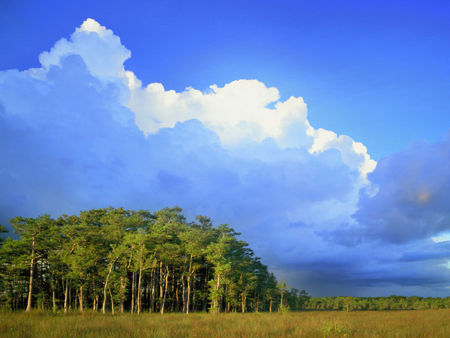 Above: Roseate Spoonbills.
Above: Roseate Spoonbills.Below: Everglades Snail Kite
(one of only 650 remaining birds)

Audubon/SFWMD Birding Tours
Take Flight in 2009,
Can Generate Benefits
to Local Economies
An Everglades restoration project just south of Lake Okeechobee lived up to its reputation as a national bird-watching location as volunteers with the Hendry-Glades Audubon Society partnered with the South Florida Water Management District (SFWMD) to document 112 species and more than 92,600 birds during the 109th national Christmas Bird Count this January. Known as “citizen science,” bird counts are vital to studies of the long-term health and status of bird populations.
More than 50 participants made the trip to Stormwater Treatment Area (STA) 5 in Hendry County for the day of bird watching. Of the diverse array of bird species sighted at the constructed wetland, American coots were by far the most abundant with 37,618 counted. Birders also took note of 31 snail kites, which are endemic to the Everglades area, and spotted some rarer species such as the short-tailed hawk and Cassin’s kingbird, a species more common in states west of Texas.
“You might spot a sandhill crane in your backyard, but it is a truly special experience to see hundreds of them together with so many other species of all sizes and colors in one beautiful place,” said SFWMD Executive Director Carol Ann Wehle. “Along with their recreational value, these treatment wetlands are wildlife havens that remind us of the environmental and economic significance of Everglades restoration.” The bird count at STA 5 served as a prelude to another partnership year of Audubon/SFWMD birding tours that showcase wildlife and public access on lands managed in perpetuity by the District for Everglades restoration. The 6,000-acre constructed wetland, just south of Clewiston, is today one of 489 sites on The Great Florida Birding Trail. Sponsored by the Florida Fish and Wildlife Conservation Commission, the sites are selected for their prolific bird watching or bird education opportunities.
Birding, a national pastime, is big business, with 48 million people observing birds both around the home and through vacation travel. A 2001 report by the U.S. Fish and Wildlife Service concluded that nationwide birding generated $32 billion in retail sales and created 863,406 jobs.
Non-consumptive bird use (non-hunting activities) supported more than 19,000 jobs in Florida in 2006, and wildlife viewing activities generated more than $3 billion statewide that year, according to a state report. Second in the nation only to California, birding generates an estimated $477 million in retail sales in Florida every year.
Fast becoming renowned as havens for birds and wildlife, Stormwater Treatment Areas are the water-cleaning workhorses of Everglades restoration, cleansing phosphorus from the water flowing into the remnant Everglades. Over the last 15 years, the District has constructed more that 45,000 acres of treatment wetlands to improve the quality of water entering the famed River of Grass.
For more information about recreation on public lands managed by the District, visit the SFWMD recreation guide. For more information on Florida bird watching, visit The Great Florida Birding Trail.



